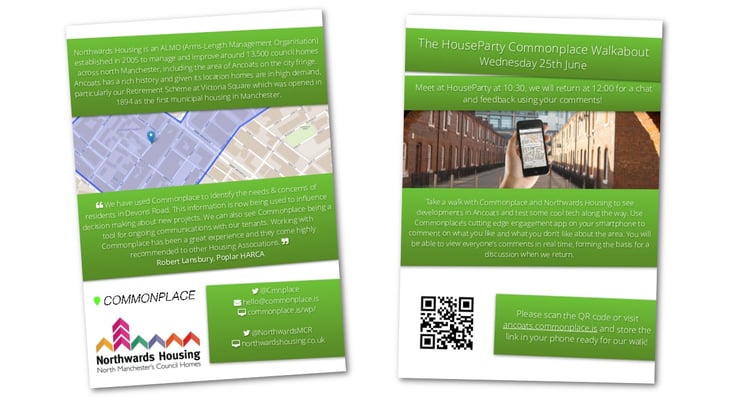Universal Credit may have an interesting and possibly unintended consequence in bridging the “digital divide”. This was one of several intriguing insights I picked up in Manchester last week, when Ali and I took part in HouseParty, a housing policy and innovation event organised by our colleagues at HACT and The Social Change Agency.
HouseParty brought together innovators, movers and shakers from the social housing world, at the fringe of the massive Chartered Institute of Housing conference. We were there to network, learn, absorb and to conduct a live demonstration of Commonplace (which I’ll come back to).
The main gateway to Universal Credit is on-line, meaning the social landlords face a risk if their tenants can’t access it as they cannot go on-line. The answer? Innovative Housing Associations are supporting digital inclusion through a variety of means:
- Providing tenants tablet computers with bespoke apps to assist them in going on-line, applying for benefits and carrying out other actions relating to their tenancy.
- Negotiating innovative deals to supply Broadband to properties cheaply and with contract structures that don’t create complicated transfer and liability issues when tenants move.
- Bringing in social enterprises to help train tenants, such as Student@home.
As one presenter put it, technology is now “cheap as chips” - a complete reversal from the times when it was seen exclusively as a major, long-term capital investment. While Big Systems still have their essential place, sharing technology widely can be done at unimaginably low cost - one demonstration project was deploying a £30 Android tablet.
The emergence of social landlords as promoters of web connectivity among some of the socio-economically weakest communities is hugely important for Commonplace. It will widen the scope for digital engagement, overcoming access barriers. Our goal is to work with social housing providers to incorporate Commonplace in their core set of applications, enabling residents to comment on their locality with our hallmark simplicity and transparency.
To demonstrate Commonplace we joined forces with Northwards Housing (thank you Greig Lees!) for a walking tour of Ancoats. HACT prepared a social profile using their Community Insight service; Greig led a fantastically interesting tour of this fringe of centre neighbourhood, rich with history (lots of old mills, early social housing and the knowledge that Frederick Engels lived there!) - and about 15 housing executives and specialists commented on what they saw using Commonplace. When we returned to the HouseParty venue, we could immediately show the comments on the Commonplace Ancoats map and a sample aggregate presentation through the real-time Commonplace Client Dashboard. Everything worked pretty much as it should have and Commonplace felt very “right” in this setting.
.png)

